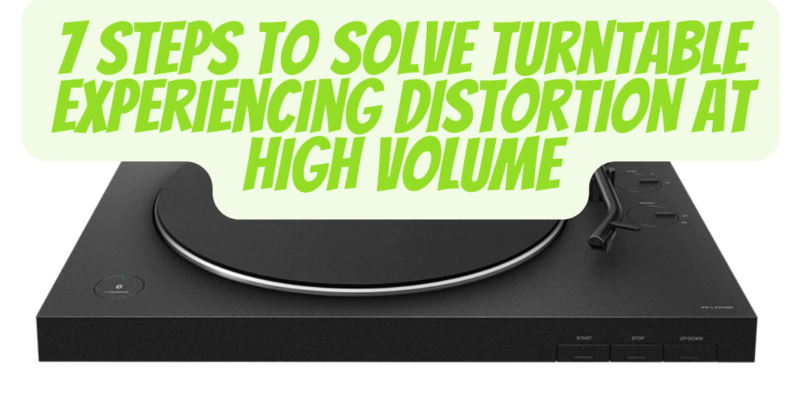Here are 7 suggested steps to solve Turntable experiencing distortion at high volume.
1. Upgrade speakers/amplifier
Invest in high-quality speakers and amplifier that can handle the output from your turntable. Investing in high-quality speakers and amplifiers helps to reduce high volume distortion from your turntable by providing a clearer and more accurate sound reproduction. Good speakers have a strong, rigid construction that minimizes vibrations and allows for precise sound waves to be emitted. Amplifiers with a high signal-to-noise ratio, low-distortion circuitry, and powerful output stages can better handle high volumes without introducing additional distortions. The combination of high-quality speakers and amplifiers can help ensure that your turntable produces clean, accurate sound at all volume levels.
2. Adjust the volume
Reduce the volume to a level that the equipment can handle without distorting the sound. Adjusting the volume can help to handle high volume distortion output from your turntable by reducing the volume to a level where the speakers and amplifier can handle the signal without introducing additional distortions. By keeping the volume within the recommended range for the speakers and amplifier, you can prevent overloading and distortion that can degrade the sound quality. Additionally, by controlling the volume, you can ensure that the speakers are not driven beyond their limits and that the sound is being produced at an appropriate level for your listening environment.
3. Clean or replace stylus
Clean the stylus with a stylus brush and replace it if it is worn or damaged. Cleaning or replacing the stylus on your turntable can help to handle high volume distortion output by improving the sound quality and reducing the amount of noise in the signal. A dirty or worn stylus can cause a variety of audio problems, including increased distortion, reduced clarity, and reduced tracking ability, which can all contribute to high volume distortion. Cleaning the stylus can remove any debris that may be affecting its performance, while replacing a worn stylus can ensure that you are getting the best possible sound from your turntable. By improving the performance of the stylus, you can help to reduce high volume distortion and produce a clearer, more accurate sound.
4. Clean records
Clean the records before playing them to remove any dust or debris that can cause audio distortion. Cleaning records can help to handle high volume distortion output from your turntable by reducing the amount of noise and debris in the signal. Dust, dirt, and other contaminants on the surface of a record can cause skips, pops, and other audio problems that can contribute to high volume distortion. By cleaning the records before playing them, you can help to reduce these problems and produce a clearer, more accurate sound. There are a variety of record cleaning products and techniques available, so you can choose the best option for your needs. Additionally, taking proper care of your records and keeping them clean can help to extend their life and ensure that you are getting the best possible sound from your turntable.
5. Check cartridge alignment
Make sure the cartridge is properly aligned with the turntable, following the manufacturer’s instructions. Checking cartridge alignment can help to handle high volume distortion output from your turntable by ensuring that the stylus is properly tracking the grooves of the record. An incorrectly aligned cartridge can cause problems such as increased distortion, reduced clarity, and reduced tracking ability, which can all contribute to high volume distortion. By checking the alignment, you can ensure that the stylus is positioned correctly and tracking the grooves as it should. There are a variety of tools available for checking cartridge alignment, including protractors, alignment jigs, and test records. By using these tools to check and adjust the alignment of your cartridge, you can help to reduce high volume distortion and produce a clearer, more accurate sound.
6. Check the condition of records
Replace warped or scratched records to prevent audio distortion. Checking the condition of records can help to handle high volume distortion output from your turntable by reducing the amount of noise and skipping in the signal. Damaged or worn records can cause skips, pops, and other audio problems that can contribute to high volume distortion. By checking the condition of your records, you can identify any issues that may be affecting their performance and take steps to address them. This can include repairing or replacing damaged records, and taking proper care of your collection to help extend its life. Additionally, by ensuring that your records are in good condition, you can help to reduce high volume distortion and produce a clearer, more accurate sound.
7. Check wiring
Make sure all the wiring and connections are secure and properly connected to the amplifier. Checking the wiring of your turntable and related components can help to handle high volume distortion output by ensuring that the signal is being transmitted correctly. Loose or damaged wiring can cause problems such as reduced signal strength, increased noise, and reduced clarity, which can all contribute to high volume distortion. By checking the wiring, you can identify any issues that may be affecting its performance and take steps to address them. This can include tightening loose connections, repairing or replacing damaged wiring, and ensuring that all components are properly connected. By ensuring that your wiring is in good condition, you can help to reduce high volume distortion and produce a clearer, more accurate sound.
By following these steps, you should be able to reduce the amount of distortion in your turntable’s audio output and fix the high volume distortion. If the problem persists, consider seeking the help of a professional. Good luck!

